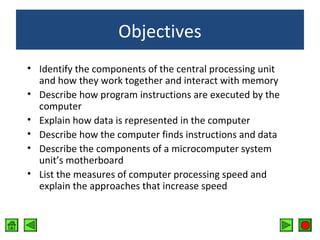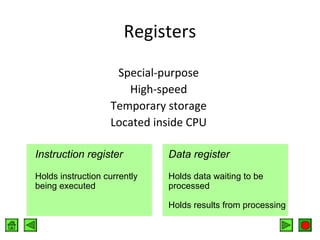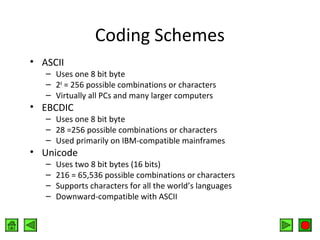Chapter4 Data Processing
- 2. Objectives • Identify the components of the central processing unit and how they work together and interact with memory • Describe how program instructions are executed by the computer • Explain how data is represented in the computer • Describe how the computer finds instructions and data • Describe the components of a microcomputer system unit’s motherboard • List the measures of computer processing speed and explain the approaches that increase speed
- 3. Contents • The CPU • Types of Storage • Executing Programs • Finding Data in Memory • The System Unit • Microprocessor • Semiconductor Memory • Bus Line • Speed and Power
- 4. The CPU
- 5. The CPU • Converts data into information • Control center • Set of electronic circuitry that executes stored program instructions • Two parts – Control Unit (CU) – Arithmetic Logic Unit (ALU)
- 6. Control Unit CU • Part of the hardware that is in-charge • Directs the computer system to execute stored program instructions • Communicates with other parts of the hardware
- 7. Arithmetic / Logic Unit ALU Performs arithmetic operations Performs logical operations
- 9. Logical Operations • Evaluates conditions • Makes comparisons • Can compare – Numbers – Letters – Special characters
- 10. Registers Special-purpose High-speed Temporary storage Located inside CPU Instruction register Data register Holds instruction currently being executed Holds data waiting to be processed Holds results from processing
- 11. Types of Storage • Secondary – Data that will eventually be used – Long-term • Memory – Data that will be used in the near future – Temporary – Faster access than storage • Registers – Data immediately related to the operation being executed – Faster access than memory
- 12. Measuring Storage Capacity KB – kilobyte • 1024 bytes • Some diskettes • Cache memory MB – megabyte • Million bytes • RAM GB – gigabyte • Billion bytes • Hard disks • CDs and DVDs TB – terabytes • Trillion bytes • Large hard disks
- 13. Memory Many Names Primary storage Primary memory Main storage Internal storage Main memory
- 14. Main Types of Memory RAM Random Access Memory ROM Read Only Memory
- 15. RAM • Requires current to retain values • Volatile • Data and instructions can be read and modified • Users typically refer to this type of memory
- 16. What’s in RAM? • • • • Operating System Program currently running Data needed by the program Intermediate results waiting to be output
- 17. ROM • Non-volatile • Instructions for booting the computer • Data and instructions can be read, but not modified • Instructions are typically recorded at factory
- 18. Executing Programs • CU gets an instruction and places it in memory • CU decodes the instruction • CU notifies the appropriate part of hardware to take action • Control is transferred to the appropriate part of hardware • Task is performed • Control is returned to the CU
- 19. Machine Cycle I-time • CU fetches an instruction from memory and puts it into a register • CU decodes the instruction and determines the memory location of the data required
- 20. Machine Cycle E-time • Execution – CU moves the data from memory to registers in the ALU – ALU is given control and executes the instruction – Control returns to the CU • CU stores the result of the operation in memory or in a register
- 22. System Clock • System clock produces pulses at a fixed rate • Each pulse is one Machine Cycle • One program instruction may actually be several instructions to the CPU • Each CPU instruction will take one pulse • CPU has an instruction set – instructions that it can understand and process
- 23. Finding Data in Memory • Each location in memory has a unique address – Address never changes – Contents may change • Memory location can hold one instruction or piece of data • Programmers use symbolic names
- 24. Data Representation On/Off Binary number system is used to represent the state of the circuit
- 25. Bits, Bytes, Words • BIT – Binary DigIT – On/off circuit – 1 or 0 • BYTE – 8 bits – Store one alphanumeric character • WORD – Size of the register – Number of BITS that the CPU processes as a unit
- 26. Coding Schemes • ASCII – Uses one 8 bit byte – 28 = 256 possible combinations or characters – Virtually all PCs and many larger computers • EBCDIC – Uses one 8 bit byte – 28 =256 possible combinations or characters – Used primarily on IBM-compatible mainframes • Unicode – – – – Uses two 8 bit bytes (16 bits) 216 = 65,536 possible combinations or characters Supports characters for all the world’s languages Downward-compatible with ASCII
- 27. The System Unit The Black Box • Houses electronic components – Motherboard – Storage devices – Connections • Some Apple Macintosh models have system unit inside monitor
- 28. The System Unit The Black Box Motherboard • Microprocessor chip • Memory chips • Connections to other parts of the hardware • Additional chips may be added – math coprocessor
- 29. The System Unit The Black Box Storage Devices Hard drive Floppy drive CD-ROM drive DVD-ROM drive
- 30. Microprocessor • • • • CPU etched on a chip Chip size is ¼ x ¼ inch Composed of silicon Contains millions of transistors – Electronic switches that can allow current to pass through
- 31. Microprocessor Components • • • • Control Unit – CU Arithmetic / Logic Unit – ALU Registers System clock
- 32. Building a Better Microprocessor • Computers imprint circuitry onto microchips – Cheaper – Faster • Perform functions of other hardware – Math coprocessor is now part of microprocessor – Multimedia instructions are now part of microprocessor
- 33. Building a Better Microprocessor The more functions that are combined on a microprocessor: • The faster the computer runs • The cheaper it is to make • The more reliable it is
- 34. Types of Microprocessors Intel Intel-compatible • Pentium • Celeron • Xeon and Itanium • Cyrix • AMD
- 35. Types of Microprocessors • PowerPC – Cooperative efforts of Apple, IBM, and Motorola – Used in Apple Macintosh family of PCs – Found in servers and embedded systems • Alpha – Manufactured by Compaq – High-end servers and workstations
- 36. Semiconductor Memory • • • • • • • Reliable Compact Low cost Low power usage Mass-produced economically Volatile Monolithic – All circuits together constitute an inseparable unit of storage
- 37. Semiconductor Memory CMOS • Complementary metal oxide semiconductor • Uses little electricity • Used in PC to store hardware settings that are needed to boot the computer • Retains information with current from battery
- 38. RAM • • • • • • Keeps the instructions and data for current program Data in memory can be accessed randomly Easy and speedy access Volatile Erased Written over
- 39. Types of RAM SRAM • Retains contents as long as power is maintained • Faster than DRAM
- 40. Types of RAM DRAM • Must be constantly refreshed • Used for most PC memory because of size and cost • SDRAM – faster type of DRAM • Rambus DRAM – Faster than SDRAM – Expensive
- 41. Adding RAM • Purchase memory modules that are packaged on circuit boards • SIMMS – Chips on one side • DIMMS – Chips on both sides • Maximum amount of RAM that can be installed is based upon the motherboard design
- 42. ROM • Programs and data that are permanently recorded at the factory • Read • Use • Cannot be changed by the user • Stores boot routine that is activated when computer is turned on • Nonvolatile
- 43. PROM • Programmable ROM • ROM burner can change instructions on some ROM chips
- 44. Bus Line • Paths that transport electrical signals • System bus – Transports data between the CPU and memory • Bus width – Number of bits of data that can be carried at a time – Normally the same as the CPUs word size • Speed measured in MHz
- 45. Bus Line Larger bus width = More powerful computer CPU can transfer more data at a time = Faster computer = More memory available CPU can reference larger memory addresses CPU can support a greater number and variety of instructions
- 46. Expansion Buses • Connect the motherboard to expansion slots • Plug expansion boards into slots – interface cards – adapter cards • Provides for external connectors / ports – Serial – Parallel
- 47. Expansion Buses
- 48. PC Buses and Ports ISA Slow-speed devices like mouse, modem PCI High-speed devices like hard disks and network cards AGP Connects memory and graphics card for faster video performance USB Supports “daisy-chaining” eliminating the need for multiple expansion cards; hot-swappable IEEE 1394 High-speed bus connecting video equipment to the (FireWire) computer PC Card Credit card sized PC card devices normally found on laptops
- 49. Speed and Power What makes a computer fast? • • • • • • Microprocessor speed Bus line size Availability of cache Flash memory RISC computers Parallel processing
- 50. Computer Processing Speed Time to execute an instruction • Millisecond • Microsecond • Nanosecond – Modern computers • Picosecond – In the future
- 51. Microprocessor Speed • Clock speed – Megahertz (MHz) – Gigahertz (GHz) • Number of instructions per second – Millions of Instructions Per Second (MIPS) • Performance of complex mathematical operations – One million floating-point operations per second (Megaflop )
- 52. Cache • Small block of very fast temporary memory • Speed up data transfer • Instructions and data used most frequently or most recently
- 53. Cache P R O C E S S O R Step 1 Processor requests data or instructions Step 3 Transfer to main CPU and cache R Cache A M Step 2 Go to address in main memory and read Next processor request • Look first at cache • Go to memory
- 54. Types of Cache • Internal cache – Level 1 (L1) – Built into microprocessor – Up to 128KB • External cache – – – – – – Level 2 (L2) Separate chips 256KB or 512 KB SRAM technology Cheaper and slower than L1 Faster and more expensive than memory
- 55. Flash Memory • Nonvolatile RAM • Used in – Cellular phones – Digital cameras – Digital music recorders – PDAs
- 56. Instruction Sets • CISC Technology – Complex Instruction Set Computing – Conventional computers – Many of the instructions are not used • RISC Technology – – – – Reduced Instruction Set Computing Small subset of instructions Increases speed Programs with few complex instructions • Graphics • Engineering
- 57. Types of Processing • Serial processing – Execute one instruction at a time – Fetch, decode, execute, store • Parallel Processing – Multiple processors used at the same time – Can perform trillions of floating-point instructions per second (teraflops) – Ex: network servers, supercomputers
- 58. Types of Processing • Pipelining – Instruction’s action need not be complete before the next begins – Fetch instruction 1, begin to decode and fetch instruction 2


























































